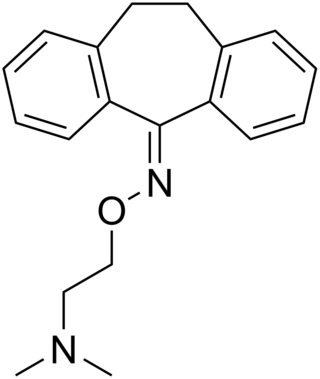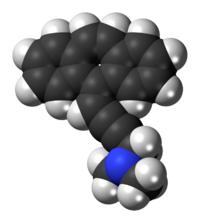
Tricyclic antidepressants (TCAs) are a class of medications that are used primarily as antidepressants. TCAs were discovered in the early 1950s and were marketed later in the decade. They are named after their chemical structure, which contains three rings of atoms. Tetracyclic antidepressants (TeCAs), which contain four rings of atoms, are a closely related group of antidepressant compounds.

Maprotiline, sold under the brand name Ludiomil among others, is a tetracyclic antidepressant (TeCA) that is used in the treatment of depression. It may alternatively be classified as a tricyclic antidepressant (TCA), specifically a secondary amine. In terms of its chemistry and pharmacology, maprotiline is closely related to such-other secondary-amine TCAs as nortriptyline and protriptyline and has similar effects to them, albeit with more distinct anxiolytic effects. Additionally, whereas protriptyline tends to be somewhat more stimulating and in any case is distinctly more-or-less non-sedating, mild degrees of sedation may be experienced with maprotiline.

Nortriptyline, sold under the brand name Aventyl, among others, is a tricyclic antidepressant. This medicine is also sometimes used for neuropathic pain, attention deficit hyperactivity disorder (ADHD), smoking cessation and anxiety. Its use for young people with depression and other psychiatric disorders may be limited due to increased suicidality in the 18–24 population initiating treatment. Nortriptyline is not a preferred treatment for attention deficit hyperactivity disorder or smoking cessation. It is taken by mouth.

Butriptyline, sold under the brand name Evadyne among others, is a tricyclic antidepressant (TCA) that has been used in the United Kingdom and several other European countries for the treatment of depression but appears to no longer be marketed. Along with trimipramine, iprindole, and amoxapine, it has been described as an "atypical" or "second-generation" TCA due to its relatively late introduction and atypical pharmacology. It was very little-used compared to other TCAs, with the number of prescriptions dispensed only in the thousands.

Tricyclics are cyclic chemical compounds that contain three fused rings of atoms.

Tricyclic antidepressant overdose is poisoning caused by excessive medication of the tricyclic antidepressant (TCA) type. Symptoms may include elevated body temperature, blurred vision, dilated pupils, sleepiness, confusion, seizures, rapid heart rate, and cardiac arrest. If symptoms have not occurred within six hours of exposure they are unlikely to occur.

Quinupramine is a tricyclic antidepressant (TCA) used in Europe for the treatment of depression.

Metapramine is a tricyclic antidepressant (TCA) developed by Rhone Poulenc that was introduced for the treatment of depression in France in 1984. In addition to its efficacy against affective disorders, it also has analgesic properties, and may be useful in the treatment of pain.

Noxiptiline, also known as noxiptyline and dibenzoxine, is a tricyclic antidepressant (TCA) that was introduced in Europe in the 1970s for the treatment of depression. It has imipramine-like effects, acting as a serotonin and norepinephrine reuptake inhibitor, among other properties. Of the TCAs, noxiptiline has been described as one of the most effective, rivaling amitriptyline in clinical efficacy.

Azepindole (McN-2453) is a tricyclic compound with antidepressant and antihypertensive effects that was developed in the late 1960s but was never marketed.

Ketipramine (G-35,259), also known as ketimipramine or ketoimipramine, is a tricyclic antidepressant (TCA) that was tested in clinical trials for the treatment of depression in the 1960s but was never marketed. It differs from imipramine in terms of chemical structure only by a single ketone group, and is approximately equivalent in effectiveness as an antidepressant in comparison.

Tampramine (AHR-9,377) is a tricyclic antidepressant (TCA) which was developed in the 1980s but was never marketed. Despite being a TCA, it acts as a selective norepinephrine reuptake inhibitor and has negligible affinity for adrenergic, histaminergic, and muscarinic receptors. It was found to be effective in the forced swim test (FST) model of depression in animal studies but is not known to have ever been trialed in humans.

Fluotracen (SKF-28,175) is a tricyclic drug which has both antidepressant and antipsychotic activity. This profile of effects is similar to that of related agents like amoxapine, loxapine, and trimipramine which may also be used in the treatment of both depression and psychosis. It was believed that such duality would be advantageous in the treatment of schizophrenia, as depression is often comorbid with the disorder and usual antipsychotics often worsen such symptoms. In any case, however, fluotracen was never marketed.

Tienopramine is a tricyclic antidepressant (TCA) which was never marketed. It is an analogue of imipramine where one of the benzene rings has been replaced with a thiophene ring.

Mezepine is a tricyclic antidepressant (TCA) that was never marketed.

Enprazepine is a tricyclic antidepressant (TCA) which was never marketed.

Depramine, also known as balipramine (BAN) and as 10,11-dehydroimipramine, is a tricyclic antidepressant (TCA) which was never marketed.

Amezepine is a tricyclic antidepressant (TCA) which was never marketed.

Dibenzoxepin, or dibenz[b,e]oxepin, is a tricyclic compound. It is the parent structure of certain drugs such as the tricyclic antidepressant doxepin and the analgesic fluradoline. The former is the only tricyclic antidepressant that is a dibenzoxepin.

Chloracyzine is an antidepressant and coronary vasodilator of the phenothiazine class, invented in Russia and used as an anti-anginal agent. It was found not to have antipsychotic activity, but was instead the first Russian tricyclic drug with antidepressant action.





















